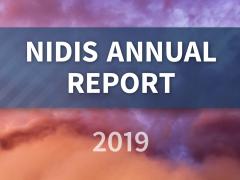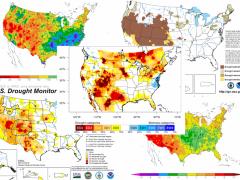New Report on Drought and Outdoor Recreation
Outdoor recreation is a major contributor to the Intermountain West’s economy, but the future viability of many businesses—particularly small businesses—in the industry is threatened by their drought vulnerabilities and the region’s projected increases in drought severity and frequency.
In 2019, NIDIS partnered with the University of Colorado’s Masters of the Environment Graduate Program to research drought information needs of the outdoor recreation industry in the Intermountain West Drought Early Warning System (Arizona, Colorado, New Mexico, Utah, Wyoming), with the goal of addressing information needs and strengthening the industry’s drought resilience. While the project focused on the Rocky Mountain states, much of the information presented can apply to other regions.
For this project, Masters of the Environment graduate students worked with NIDIS to research drought impacts on and information needs of water-based outdoor recreation businesses, with a focus on the following subsectors:
- ski resorts
- snow-based sports (e.g., dog sledding, Nordic skiing)
- lake-based sports (e.g., boating, paddle boarding)
- fishing
- rafting
- small retailers.
Between May and August 2019, 112 water-based outdoor recreation businesses (ski resorts, snow-based, fishing, rafting, lake-based, and small retailers) were interviewed and surveyed to determine how drought impacts their operations, adaptation strategies employed to mitigate negative drought impacts, and drought information needs to reduce the vulnerability of the industry.
As discussed in the literature review in the research report, Drought and Outdoor Recreation: Impacts, Adaptation Strategies, and Information Gaps in the Intermountain West, and verified in the field, drought creates substantial environmental impacts. These impacts are both positive and negative, as well as direct and indirect in nature. Low streamflows, reduced snowpack development, and warming temperatures are all directly degrading water resources integral to the outdoor recreation industry. Taken as a whole, the window of opportunity for outdoor recreation activities is becoming shorter and shorter. Reduced snowpack is limiting the length of the ski or snow-based seasons and low flows limit the length of the riversport season as well as reservoir levels needed for lake-based recreation. In the case of the fishing subsector, extreme low flows and high temperatures are also harming fish species essential to anglers.
Wildfires, fueled by hot and dry conditions, are also having direct and indirect impacts on outdoor recreation businesses. In some cases, fires directly affect the regions where businesses operate and may prevent access for recreation or result in National Forest closures. In other cases, the public’s perception of regional wildfires drives customers to other areas. In this latter category of cases, the wildfire may not actually be impacting a customer’s chosen recreational activity, but nevertheless acts as a deterrent.
These environmental impacts of drought generally serve to reduce visitation and sales in the subsectors analyzed in this report, with a few exceptions. Low streamflows benefit fly fishing companies to an extent, until water temperatures begin to affect the wellbeing of the fish. Low snowpack in one region may also drive snowsport enthusiasts to higher elevations, benefiting those areas to an extent. Across the industry, businesses have reported 20% to 50% reductions in annual revenue during drought years. These losses are not evenly distributed across the various subsectors and further study is required to determine which subsectors are the most sensitive to drought.

Under drought conditions, all supply-side participants in the outdoor recreation retail subsector are acting to minimize their risk. This has precipitated a “transfer of risk” from manufacturers down to the individual. Manufacturers might seek to protect themselves from potential losses by moving their ordering deadlines up in time. This forces retail stores to make earlier purchases, locking in revenue early. Those same stores, faced with below-average sales during a drought year, may choose to recoup their losses by laying off employees. This approach effectively transfers the financial burden of the drought onto individuals who may be poorly situated to manage the burden because there are fewer employment opportunities mid-season.
One final theme which emerged in the field was that drought creates significant mental health challenges for business owners. As the viability of a business is threatened by drought, business owners are forced to work harder, make riskier choices, and generally expose themselves to severe financial consequences in order to stay afloat. Particularly distressed owners reported refinancing their homes for extra money, renting storage units to hold overstock, and generally losing sleep. Ultimately, this is creating unquantified economic and public health impacts which are fruitful areas of future study.
This research report presents the research methods and findings, including the following detailed information for each subsector:
- how drought impacts business operations
- adaptation strategies of the businesses
- current drought and weather information use
- drought information needs.
This report also seeks to provide NIDIS with recommendations for addressing drought information gaps of outdoor businesses with the aim of addressing those gaps and increasing the resilience of this industry in the Intermountain West.
Additional resources:
NIDIS and the University of Colorado's Master of the Environment Graduate Program have previously hosted a seminar and webinar on this project plus other topics on the effects of drought on outdoor recreation.





